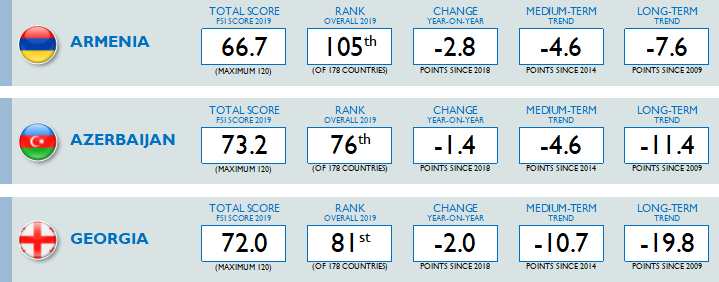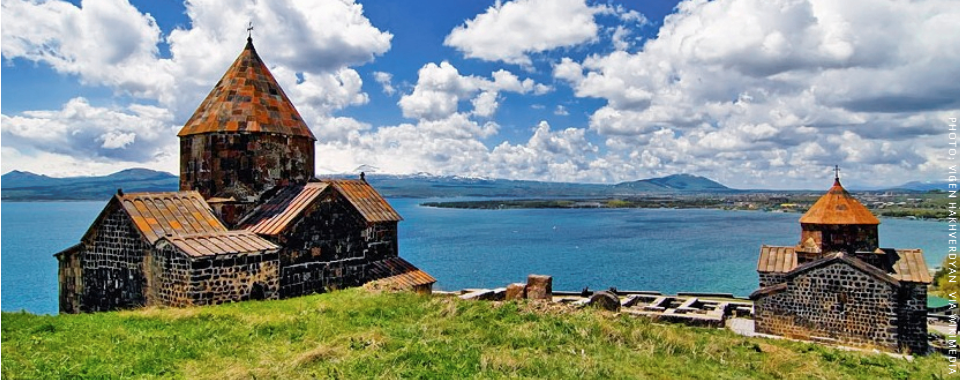BY PATRICIA TAFT
Straddling Europe and Asia, the South Caucasus has long been considered a region of strategic importance for past empires and modern-day superpowers. It is also a land where the echoes of the Cold War continue to play out decades after the collapse of the Former Soviet Union and the realignment of the global world order. In addition to being a pivotal region for the economic and security interests of the West and Russia, the South Caucasus has had its own regional and internal challenges over the past two decades. In Georgia, two breakaway regions remain under Russia’s sphere of influence, and firmly outside of Tbilisi’s control. In Armenia and Azerbaijan, a long simmering conflict over the disputed region of Nagorno Karabakh continues to periodically erupt in violence, and keeps the two countries locked in a semi-permanent war posture. This has had deleterious effects not only on any attempts to unify the region, but is also a constant strain on the economy, more so in Armenia than oil-rich Azerbaijan. These so-called “frozen conflicts” have further created wide swaths of no-go zones in the South Caucasus, making travel and trade between and among the countries costly and complicated.

In 2018, however, there was cause for cautious optimism in a region where the ghosts of superpowers past and present continue to exert outsized influence. This is most apparent in two countries in particular: Georgia and Armenia. Georgia, sixteen years after the Rose Revolution, and almost 11 years after a Russian invasion that nearly drew in NATO allies and plunged the region into war, continues to make slow but steady progress. Following an expected worsening across most FSI indicators in 2009, after the Russian incursion into Georgian territory, the country has managed to cut the infant mortality rate by half since 2008, decreased poverty rates by nearly 40% between 2008 and 2016, while homicide rates, once one of the highest in the region, have fallen by 90% over the past decade. On the democracy front, Georgia has also made steady progress, holding successive presidential and parliamentary elections over the years that have been declared mostly free and fair by international observers. In late 2018, despite concerns over harassment of civil society organizations and corruption related to the use of administrative resources, Georgia elected the first female president in the region. It also has steadily worked to improve its legal and regulatory frameworks, encouraging more foreign direct investment in the country and opening its economy to businesses outside of the region. Overall, looking at across-the-board improvements over five- and ten-year FSI trends, Georgia has emerged as the top performer, a testament to how very far it has come since the bleak days of 2008-2009.
One of the biggest surprises on this year’s FSI, however, was Armenia, which improved by nearly three points overall. Perhaps more so than any other country in the region, Armenia has had to perform a delicate balancing act between Russia and the West, which for years has kept the country hamstrung both economically and politically. Russia maintains a military base in Armenia and has been the main supplier of Armenian defense equipment, particularly for the standoff with Azerbaijan over Nagorno-Karabakh. Armenia also maintains a cooperative defense agreement with Moscow that has, in the past, appeared to grant Russia outsized influence on Armenian defense and foreign policy. At the same time, Armenia has attempted to counter this narrative of Russian control by entering into a variety of cooperative economic and foreign policy agreements with the EU and NATO. However, in comparison to its neighbor Georgia, Armenia appeared to be slowly stumbling along in fits and starts, taking one step forward that was often countered by several steps back. Last year, however, that seemed to change. Ignited by student protests early in the year and building upon a popular groundswell of disillusionment and anger with corrupt and entrenched political practices and poor standards of living, Armenia underwent its own “velvet revolution” in May, electing the reformist Prime Minister, Nikol Pashinyan. Although still very much in the early days, the country’s new leadership seems determined to bring it into the future by implementing a similar scale of reforms and anti-corruption measures that brought Georgia out of the dark days of its past. Moreover, it has pledged to restore popular confidence in government and purge many of the people and practices that have kept Armenia stalled and its potential unrealized.
It would be impossible to mention the progress in Georgia and Armenia without briefly looking at Azerbaijan, a country whose oil wealth has allowed it to make economic leaps and gains over its neighbors, although these economic improvements have not necessarily translated into broader social or political reforms. Largely as a result of its booming oil sector, Azerbaijan has made notable gains in improving its FSI score in the areas of demographic pressures and economic inequality, with infant mortality rates falling by half between 2007 and 2017, and poverty rates (as measured by the national poverty line) falling by two-thirds between 2012 and 2017.
Azerbaijan has also taken strides to improve its investment climate, as reflected by the capital city of Baku, whose glittering skyline and main boulevards are lined with the names of European and American companies and investment firms. Outside of the capital, however, progress has proceeded at a much slower pace, with rural areas still struggling to catch up to the capital. Azerbaijan is also a tightly controlled country which finds itself having to balance its own national interests with outside pressures from Turkey, Iran and Russia. Like Armenia, however, Azerbaijan in many ways remains locked in the past due to the conflict in Nagorno-Karabakh, which both allies and adversaries in the region (and further afield) have used to promote their own interests and influence over the years. Although the pro-democracy movements in Georgia and Armenia have only been mirrored by the slightest of rumblings in Azerbaijan, 2019 began with thousands protesting in Baku demanding the release of political prisoners and a popular anticorruption blogger, potentially signaling that change is on the horizon.
Finally, while both Georgia and Armenia’s democratic trajectories are worthy of commendation and support, cautious optimism is still warranted. The shadow of Russia looms large in the region, and the United States and the European Union are beset by their own challenges that, in many ways, have resulted in a turn inwards. Additionally, there remains vested interests in both Georgia and Armenia in maintaining a cautious alliance with Russia, while simultaneously pursuing their own paths towards greater national and regional autonomy. Only time will tell whether these two countries will maintain the momentum of the pro-democracy forces sweeping the region, or whether the ghosts of the past will rise up once again, trying win the future.
